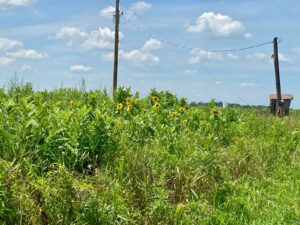Essential for the Monarch butterfly life cycle
Monarch caterpillars feed exclusively on the leaves and the adult butterflies need milkweed to lay their eggs. They also feed on the nectar of the flowers, along with other flower species. Milkweeds have complex flowers; when you examine the individual flowers that make up the pink flower balls you will be amazed at their form and detail.
Growing milkweed in your garden
In the landscape, common milkweed is often too aggressive and weedy to be widely appropriate for beds and borders. It is much better suited to unmaintained edges of fields or thickets. If you already have common milkweed in the garden, you can prevent further spread by removing immature seed pods. Since milkweed is a perennial, it will emerge again in the same spot next summer, but its spread will be more limited.
 This native plant is aggressive and can be weedy. As a child, all the kids worked on the farm weeding the dreaded milkweed from the soybeans. The milkweed would jam a combine and cause breakdowns so it was important we remove them from the field. Recently I went home to visit my father and we took a ride on his gator, to my surprise there was milkweed in the majority of the cover ground. He explained to me how they seed and how good they are for the monarch butterflies and I did see several that day. He told me the famous fluffy seeds float everywhere in the fall when the pods split open. The plants also have underground rhizomes that colonize to make a large stand of many plants.
This native plant is aggressive and can be weedy. As a child, all the kids worked on the farm weeding the dreaded milkweed from the soybeans. The milkweed would jam a combine and cause breakdowns so it was important we remove them from the field. Recently I went home to visit my father and we took a ride on his gator, to my surprise there was milkweed in the majority of the cover ground. He explained to me how they seed and how good they are for the monarch butterflies and I did see several that day. He told me the famous fluffy seeds float everywhere in the fall when the pods split open. The plants also have underground rhizomes that colonize to make a large stand of many plants.
Common milkweed loves full sun and tolerates most soils, including heavy and wet sites. Try to make a place for it in your garden and you will not only enjoy the fragrance of the flowers, but very likely will see monarch butterflies enjoying the plant as well.







